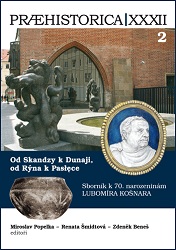Anmerkungen zur Geschichte des Stalles von der Urgeschichte bis zur Neuzeit am Beispiel von Rinderstall und Schweinekoben
Notes on the History of the Byres from Prehistory to Modern Times Using the Example of the Cattle Byre and Pig Byre
Author(s): W. Haio ZimmermannSubject(s): Agriculture, Economic history, Social history, Ancient World, Middle Ages, Modern Age, Socio-Economic Research
Published by: Univerzita Karlova v Praze, Nakladatelství Karolinum
Keywords: byre; pigsty; stable; stabling; byre economy; prehistory; pen; fold; early recent time; byre in pre- and protohistoric times; introduction of the byre; maintenance of the byre; dung; manure; manuring;
Summary/Abstract: Notes on the evolution in housing domestic animals from prehistory to modern times, based on the cattle-byre and pigsty. Succeeding three papers published in 1999, this paper deals with the byre and pigsty; structures which served many purposes, varying in time and place. They were important to collect dung, to save the farmed areas from damage during the winter, to protect the animals from raids etc. It is astonishing how well the reasons for the introduction and maintenance of the byre, as summarised by the author in 1999, match with ethnographical sources quoted by Huppertz (1948). Apart from Scandinavia and the areas on the southern edge of the North Sea, very little is known about when and why stabling was introduced in Europe, and whether it was practiced continuously or not. The presence of byres can be demonstrated by various scientific methods. When large scale excavations uncover complete yards with different types of buildings and structures, phosphate analysis is an excellent method to give insight into the use and function of these yards, providing that the researcher does not restrict himself to a few individual house plans. At present, only for the areas at the southern edge of the North Sea and in Scandinavia there are convincing P-mapping data; convincing because large numbers of data facilitate correct interpretation. Therefore phosphate analysis should also be a method of research in other European areas. By means of documentary and pictorial sources as well as ethnographic reports concerning different aspects of the byre and pigsty and the wintering of domestic animals are discussed, e.g. in which direction the cattle were stalled, their herding and tethering and the use of the byre for sleeping and the presence or absence of a hearth. Even if the results may not be directly applicable to pre- and proto-historical conditions, these sources can be helpful to produce models. This is especially interesting in the case of the pigsty, for which there is little archaeological evidence so far. And each well-preserved and undisturbed house-plan which is not phosphate mapped, is a lost opportunity. (corr. Adrie Ufkes, Groningen)
Journal: Praehistorica
- Issue Year: 32/2014
- Issue No: 2
- Page Range: 329-358
- Page Count: 30
- Language: German

